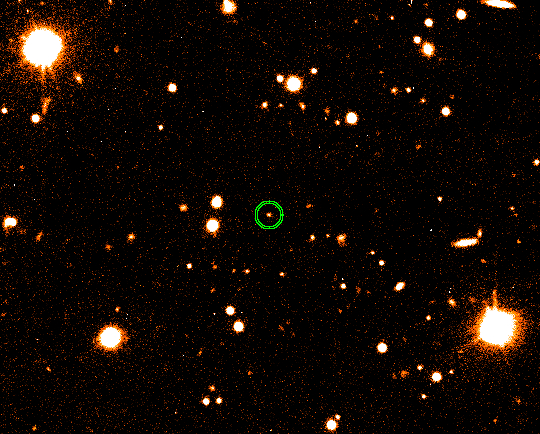Halimede (moon) on:
[Wikipedia]
[Google]
[Amazon]
Halimede , or Neptune IX, is a retrograde
 Halimede, like many of the outer satellites of Neptune, is named after one of the Nereids, the fifty daughters of
Halimede, like many of the outer satellites of Neptune, is named after one of the Nereids, the fifty daughters of
 Halimede has the second most eccentric and third most inclined orbit around Neptune. This is illustrated on the diagram in relation to other irregular satellites of Neptune. The satellites above the horizontal axis are prograde, the satellites beneath it are retrograde. The yellow segments extend from the
Halimede has the second most eccentric and third most inclined orbit around Neptune. This is illustrated on the diagram in relation to other irregular satellites of Neptune. The satellites above the horizontal axis are prograde, the satellites beneath it are retrograde. The yellow segments extend from the
Matthew Holman's Neptune's page
(by
MPC: Natural Satellites Ephemeris Service
* Mean orbital parameter
from JPL
{{DEFAULTSORT:Halimede (Moon) Moons of Neptune Irregular satellites 20020814 Moons with a retrograde orbit
irregular satellite
In astronomy, an irregular moon, irregular satellite or irregular natural satellite is a natural satellite following a distant, inclined, and often eccentric and retrograde orbit. They have been captured by their parent planet, unlike regular s ...
of Neptune. It was discovered by Matthew J. Holman
Matthew J. Holman (born 1967) is a Smithsonian Astrophysical Observatory, Smithsonian astrophysicist and lecturer at Harvard University. Holman studied at MIT, where he received his bachelor's degree in mathematics in 1989 and his PhD in planetar ...
, John J. Kavelaars, Tommy Grav, Wesley C. Fraser and Dan Milisavljevic on August 14, 2002.
Name
 Halimede, like many of the outer satellites of Neptune, is named after one of the Nereids, the fifty daughters of
Halimede, like many of the outer satellites of Neptune, is named after one of the Nereids, the fifty daughters of Nereus
In Greek mythology, Nereus ( ; ) was the eldest son of Pontus (the Sea) and Gaia ( the Earth), with Pontus himself being a son of Gaia. Nereus and Doris became the parents of 50 daughters (the Nereids) and a son ( Nerites), with whom Nereus ...
and Doris. Before the announcement of its name on February 3, 2007 (IAUC 8802), Halimede was known by the provisional designation S/2002 N 1.
Orbit
pericentre
An apsis (; ) is the farthest or nearest point in the orbit of a planetary body about its primary (astronomy), primary body. For example, the apsides of the Earth are called the aphelion and perihelion.
General description
There are two ...
to the apocentre, showing the eccentricity. It is also worth mentioning that Sao
SAO or Sao may refer to:
Places
* Sao civilisation, in Middle Africa from 6th century BC to 16th century AD
* Sao, a town in Boussé Department, Burkina Faso
* Saco Transportation Center (station code SAO), a train station in Saco, Maine, U.S. ...
and Laomedeia are similar to Halimede but they both have prograde orbits unlike Halimede which has a retrograde orbit.
Physical characteristics
Halimede is about 62 kilometers in diameter (assuming analbedo
Albedo (; ) is the measure of the diffuse reflection of solar radiation out of the total solar radiation and measured on a scale from 0, corresponding to a black body that absorbs all incident radiation, to 1, corresponding to a body that refl ...
of 0.04) and appears neutral (grey) in the visible light
Light or visible light is electromagnetic radiation that can be perceived by the human eye. Visible light is usually defined as having wavelengths in the range of 400–700 nanometres (nm), corresponding to frequencies of 750–420 te ...
. Given the very similar colour of the satellite to that of Nereid
In Greek mythology, the Nereids or Nereides ( ; grc, Νηρηΐδες, Nērēḯdes; , also Νημερτές) are sea nymphs (female spirits of sea waters), the 50 daughters of the ' Old Man of the Sea' Nereus and the Oceanid Doris, sisters ...
together with the high probability (41%) of collision in the past lifespan of the Solar System, it has been suggested that the satellite could be a fragment of Nereid.
References
External links
Matthew Holman's Neptune's page
(by
Scott S. Sheppard
Scott Sander Sheppard (born 1977) is an American astronomer and a discoverer of numerous moons, comets and minor planets in the outer Solar System.
He is an astronomer in the Department of Terrestrial Magnetism at the Carnegie Institution for Scie ...
)
MPC: Natural Satellites Ephemeris Service
* Mean orbital parameter
from JPL
{{DEFAULTSORT:Halimede (Moon) Moons of Neptune Irregular satellites 20020814 Moons with a retrograde orbit